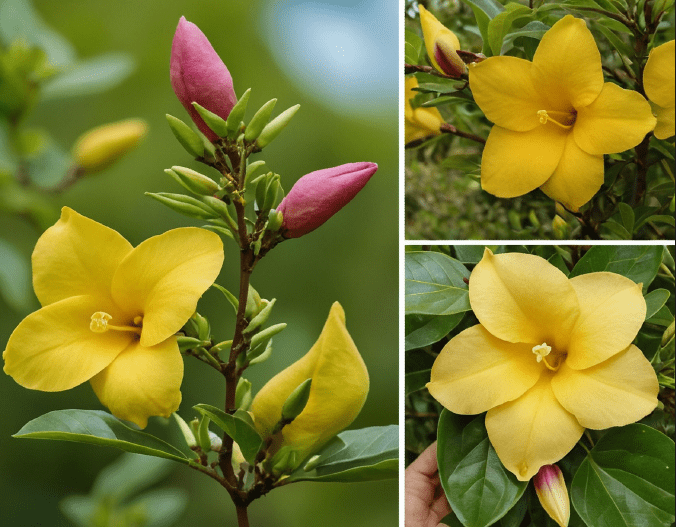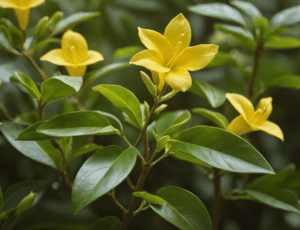
Allamanda, commonly known as the golden trumpet, is a tropical plant that captivates with its large, buttery yellow flowers and glossy leaves. Whether you’re growing it indoors or outdoors, this guide will provide essential tips to cultivate and care for your allamanda successfully.
All About Allamanda
What Is Allamanda?
Allamanda (Allamanda cathartica) is a fast-growing shrub native to warm, moist climates. Its vibrant yellow flowers and intoxicating fragrance make it a favorite among gardeners.
Varieties of Allamanda
- Allamanda cathartica: The classic variety with large yellow blooms and a brown throat.
- Dwarf Allamanda: A compact version suitable for smaller spaces.
- Purple Allamanda (Allamanda blanchetii): A rare variety with striking purple flowers.
- Yellow Allamanda (Allamanda schottii): A unique yellow-flowered species.
Growing Allamanda Indoors
Light and Temperature
- Allamanda thrives in solid light, including some direct sun.
- Please place it in an east-facing window with morning sun exposure.
Watering and Humidity
- Water liberally during the summer, ensuring good drainage.
- Mist the plant frequently to maintain humidity, especially during dry winter months.
Fertilizing and Pruning
- Feed allamanda with weak liquid fertilizer during the growing season.
- Prune in midspring before flowering to encourage bushier growth.
Troubleshooting: Keeping Your Allamanda Thriving
Even with the best care, your allamanda might encounter some minor issues. Here’s a quick guide to identify and address common problems:
- Yellowing Leaves: This can have several causes.
- Overwatering: The culprit is often soggy soil. Reduce the watering frequency and ensure good drainage.
- Nutrient Deficiency: If underwatering isn’t the issue, consider feeding your allamanda a balanced fertilizer during the growing season.
- Lack of Sunlight: Move your plant to a brighter location with more direct sun exposure (gradually if indoors).
- Lack of Blooms: There are a few reasons why your allamanda might not be flowering.
- Insufficient Light: Insufficient light is a common culprit. Ensure your plant receives at least 6 hours of bright, indirect sunlight daily.
- Nutrient Imbalance: Too much nitrogen fertilizer can promote foliage growth over blooms. Opt for a fertilizer with a higher phosphorus content during the flowering season.
- Rootbound Plant: If your allamanda is pot-bound, it might not have enough energy to flower. Repot it into a larger container with fresh potting mix.
Choosing the Right Pot
- Opt for a large container (at least 4 gallons) with excellent drainage.
- Use a rich, peat-based potting soil.
Taking Allamanda Outdoors
Acclimating to Outdoor Conditions
- Gradually move potted allamanda outdoors when consistently warm.
- Provide 4 to 6 hours of direct sunlight daily.
Caring for Outdoor Allamanda
- Continue watering, fertilizing, and pruning.
- Bring it back indoors when nighttime temperatures drop to 40°F.
Propagation and Pest Control
Propagating Allamanda

- Take stem tip cuttings in early spring.
- Use rooting hormone and pot in seed-starting soil.
Pest Management

- Watch out for aphids and mealybugs.
- Treat with insecticidal soap as needed.
Fun Fact: Allamanda Elementary School
Did you know there’s an Allamanda Elementary School in Florida? It’s named after this beautiful plant!
General FAQs
- Is Allamanda poisonous?
Yes, Allamanda contains a milky sap that can be toxic if ingested. Please keep it away from pets and children.
- Can I grow allamanda in a pot?
Absolutely! Allamanda thrives in containers. Choose a pot with good drainage and a well-draining potting mix.
- How long does Allamanda bloom?
Allamanda can bloom for several months with proper care, often from spring through fall.
- Why are my allamanda leaves turning yellow?
Yellowing leaves can indicate several issues like overwatering, underwatering, or nutrient deficiencies. Check soil moisture and adjust your care routine accordingly.
Indoor Care FAQs
- How much light does an indoor allamanda need?
Allamanda loves bright light! Please place it in a sunny window with a few hours of direct sunlight daily.
- Is my allamanda plant getting too big for indoors?
If your allamanda becomes too large, you can prune it back to control its size. Alternatively, consider a dwarf variety for indoor spaces.
Outdoor Care FAQs
- When can I plant my allamanda outdoors?
Plant allamanda outdoors when temperatures are consistently warm with no risk of frost.
- Does allamanda need a trellis?
Allamanda is a vining plant and benefits from support. Provide a trellis or fence for it to climb.
- Should I bring my allamanda indoors for winter?
Bring your allamanda indoors before temperatures drop below 40°F (4°C) if you live in a cold climate.
Here’s how I’d rewrite the list for uniqueness, while keeping it informative and accurate:
Exploring Allamanda Diversity: A Guide to Species and Synonyms
The genus Allamanda contains approximately 12 to 15 recognized species, showcasing beautiful variations in this tropical flowering plant. Below is a list of key species with notes on common synonyms used within the horticultural community:
- Allamanda angustifolia: Less commonly cultivated, identified by its thin, narrow leaves.
- Allamanda blanchetii: Known for its captivating purple or violet blooms, earning it the nicknames “purple allamanda” or “violet trumpetvine”.
- Allamanda calcicola: A species uniquely adapted to limestone-rich soil conditions.
- Allamanda cathartica: The most widespread, popular for its vibrant yellow flowers, and often referred to as “golden trumpet” or “common trumpetvine”.
- Allamanda doniana: Identified by heart-shaped leaves and striking golden flowers.
- Allamanda laevis: Characterized by its smooth foliage and bright blooms.
- Allamanda martii: A species boasting large leaves and showy flowers.
- Allamanda nobilis: Prized for its extra-large blooms and fragrant aroma.
- Allamanda oenotherifolia: Features distinct yellow flowers with reddish-brown markings.
- Allamanda polyantha: Boasts a profusion of smaller, rich yellow blossoms.
- Allamanda puberula: Characterized by fine hairs on its leaves and stems.
- Allamanda schottii: A popular choice as “bush allamanda” due to its more compact growth habit.
Please note: Botanical naming can sometimes include synonyms, where a species has been given multiple scientific names over time.
References
World Checklist of Selected Plant Families. Retrieved May 22, 2014.
de Souza-Silva, R. F. and A. Rapini. (2009). Allamanda calcicola (Apocynaceae), an overlooked new species from limestone outcrops in the States of Minas Gerais and Bahia, Brazil. Kew Bulletin 64(1), 171–74.
Allamanda. FloraBase. Western Australian Herbarium.
“Laman Web Rasmi Dewan Bandaraya Kuching Utara”. Archived from the original on 2017-11-17. Retrieved 2017-11-16.
Fakhrudin N, Waltenberger B, Cabaravdic M, Atanasov AG, Malainer C, Schachner D, Heiss EH, Liu R, Noha SM, Grzywacz AM, Mihaly-Bison J, Awad EM, Schuster D, Breuss JM, Rollinger JM, Bochkov V, Stuppner H, Dirsch VM. Identification of plumericin as a potent new scaffold inhibitor of the NF-κB pathway with anti-inflammatory activity in vitro and in vivo. Br J Pharmacol. 2013 Dec 16. doi:10.1111/bph.12558. PMID 24329519
Schmidt, D. D. F. N., et al. (2006). Evaluation of the anti-proliferative effect the extracts of Allamanda blanchetti and A. schottii on the growth of leukemic and endothelial cells. J Pharm Pharm Sci 9, 200–08.
Allamanda cathartica. Archived 2013-05-13 at the Wayback Machine Royal Botanic Gardens, Kew.
Allamanda cathartica“. Germplasm Resources Information Network. Agricultural Research Service, United States Department of Agriculture. Retrieved 29 December 2017.
Allamanda cathartica. Atlas of Florida Vascular Plants. University of South Florida.
Allamanda schottii. Germplasm Resources Information Network. Agricultural Research Service, United States Department of Agriculture. Retrieved 29 December 2017.
Conclusion
Allamanda is a stunning addition to any indoor or outdoor space. Follow these guidelines, and your allamanda will flourish, gracing your home’s tropical beauty.

























